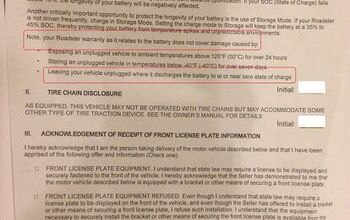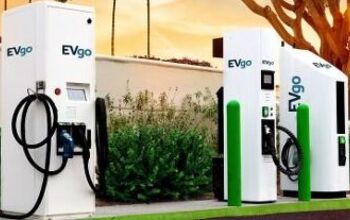Between the Lines: Chrysler's Electric Vehicle Charade
Chrysler unveiled some primo bailout bait today: three electric vehicles (EVs). Choosing CNBC as point man, ChryCo’s CEO showed-off a fully electric Dodge sports car and a Jeep and minivan hybrid. While the press has been suitably impressed, pistonheads who’ve been following (and following and following) the hoopla surrounding GM’s plug-in electric – gas hybrid Chevrolet Volt are settling-in for the long haul. Meanwhile, we must endure Auburn Hill’s spin on the whole “future vehicles” thing. Or do we? Here’s Chrysler press release…
Looking beyond hybrids…that was the mission of ENVI.
And here I thought the mission was to convince the government that Chrysler is worthy of a federal bail out. That’s why they unveiled the cars on CNBC – they are pitching Chrysler LLC to the business community as a suitable investment.
Revealed today are three electric-drive vehicles, one of which will go on sale in 2010.
One? So two-thirds of this dog and pony show is, to quote GM’s Bob Lutz, “a crock of shit?” Well, no surprise there. So which one will it be? The Jeep is no deal, right off the bat. Too low volume, doesn’t fit with brand image. So will Chrysler do it smart and build the minivan, or try to build the sports car for rich people already on the wait list for a nearly identical Tesla?
The prototypes give a glimpse of the very near future. Chrysler intends to bring advanced, electric-drive vehicles to market quickly,
They are coming very soon, do you hear us? This is not a pipe dream like that Chevy Volt, which is set to come to market in 2010 as a 2011 model. Ours are going on sale in – what did we say above? Oh, 2010 also. Nevermind.
A fleet of more than 100 Chrysler electric vehicles will be on the road in government, business and Chrysler development fleets next year.
What we’re going to do is make nice with the government (probably Santa Monica parking enforcement), then try to sell our investors by letting them drive these cars around as toys for a few months.
The Dodge EV has three primary components: a 200 kW (268 horsepower) electric motor, an advanced lithium-ion battery and an integrated power controller. The 200 kW electric-drive motor produces 480 lb.-ft. of torque, accelerating the vehicle from zero to 60 mph in less than five seconds, with a top speed of more than 120 mph.
This all sounds very familiar. Where did I hear it before? Oh right, Tesla’s website.
The Dodge EV has a range of 150 miles between recharges – more than tripe the average daily commute. To recharge the vehicle, simply plug it into a standard 110-volt household outlet. Or the recharge time can be cut in half by using a typical 220-volt household appliance power outlet.
All subject to change when we switch our design software to CAD from the current NapkinSharpieSoft. Also noteworthy: the idealistic claimed 150 mile range is less that Tesla’s idealistic claimed 244 mile range. Who is making the batteries? Who is dealing with the transmission issue that Tesla – and even partner BorgWarner – had so much trouble with? Would the car be assembled in the US or by Lotus in England?
The Jeep EV is a range-extended electric vehicle that couples the electric motor and the lithium-ion battery system with a small gasoline engine and an integrated electric generator to produce added energy. The Jeep EV has a range of 40 miles of zero-emissions, all-electric operation – no gas necessary. But for longer trips of up to 400 miles, the small gasoline engine produces energy to power the electric-drive system.
Now, since we’re done knocking off Tesla, we’ll move on to knock off the Volt. Don’t worry though. There isn’t a Snickers’ chance in Britney’s kitchen this thing will make it to production.
Since nearly 80 percent of Americans drive less than 40 miles per day, or 14,000 miles per year,
Yes, we all read the same press release from the same study, then heard Bob Lutz drop it into conversation like he thought it up in the shower. You know why people use medians instead of averages? Because averages suck.
The instant high torque and the ability to control each wheel independently results in the off-road capability consumers expect from Jeep.
Sending power to each wheel does sound very cool for off roading. So did the Jeep Rescue Concept. And the Jeep Gladiator Concept. And the Jeep JT pickup. And the Jeep Dakar concept.
The seven-passenger Chrysler EV is, like the Jeep EV, a range-extended electric vehicle that puts electric-drive technology in the segment-leading Chrysler Town & Country minivan.
Segment leading it what way? More Swivel ‘N Go than the Sienna? Leading in fleet sales?
The Chrysler EV can drive 40 miles on all-electric power, or 400 miles with the help of an integrated small displacement engine and generator. The Chrysler EV uses a 255 horsepower motor, producing 258 lb.-ft. of torque, providing zero to 60 mph acceleration in about nine seconds.
It’s a minivan. Meaning you’re supposed to fill it up with kids and hockey bags and other wholesome junk. What’s the range when there’s 1000 lbs of American goodness inside?
And so on. There’s but one takeaway here: there’s nothing to take away. Not now, and not before Chrysler is forced to face the music. Do you know it’s vaporware? No, but if you hum a few bars I can fake it.
Latest Car Reviews
Read moreLatest Product Reviews
Read moreRecent Comments
- Kmars2009 I rented one last fall while visiting Ohio. Not a bad car...but not a great car either. I think it needs a new version. But CUVs are King... unfortunately!
- Ajla Remember when Cadillac introduced an entirely new V8 and proceeded to install it in only 800 cars before cancelling everything?
- Bouzouki Cadillac (aka GM!!) made so many mistakes over the past 40 years, right up to today, one could make a MBA course of it. Others have alluded to them, there is not enough room for me to recite them in a flowing, cohesive manner.Cadillac today is literally a tarted-up Chevrolet. They are nice cars, and the "aura" of the Cadillac name still works on several (mostly female) consumers who are not car enthusiasts.The CT4 and CT5 offer superlative ride and handling, and even performance--but, it is wrapped in sheet metal that (at least I think) looks awful, with (still) sub-par interiors. They are niche cars. They are the last gasp of the Alpha platform--which I have been told by people close to it, was meant to be a Pontiac "BMW 3-series". The bankruptcy killed Pontiac, but the Alpha had been mostly engineered, so it was "Cadillac-ized" with the new "edgy" CTS styling.Most Cadillacs sold are crossovers. The most profitable "Cadillac" is the Escalade (note that GM never jack up the name on THAT!).The question posed here is rather irrelevant. NO ONE has "a blank check", because GM (any company or corporation) does not have bottomless resources.Better styling, and superlative "performance" (by that, I mean being among the best in noise, harshness, handling, performance, reliablity, quality) would cost a lot of money.Post-bankruptcy GM actually tried. No one here mentioned GM's effort to do just that: the "Omega" platform, aka CT6.The (horribly misnamed) CT6 was actually a credible Mercedes/Lexus competitor. I'm sure it cost GM a fortune to develop (the platform was unique, not shared with any other car. The top-of-the-line ORIGINAL Blackwing V8 was also unique, expensive, and ultimately...very few were sold. All of this is a LOT of money).I used to know the sales numbers, and my sense was the CT6 sold about HALF the units GM projected. More importantly, it sold about half to two thirds the volume of the S-Class (which cost a lot more in 201x)Many of your fixed cost are predicated on volume. One way to improve your business case (if the right people want to get the Green Light) is to inflate your projected volumes. This lowers the unit cost for seats, mufflers, control arms, etc, and makes the vehicle more profitable--on paper.Suppliers tool up to make the number of parts the carmaker projects. However, if the volume is less than expected, the automaker has to make up the difference.So, unfortunately, not only was the CT6 an expensive car to build, but Cadillac's weak "brand equity" limited how much GM could charge (and these were still pricey cars in 2016-18, a "base" car was ).Other than the name, the "Omega" could have marked the starting point for Cadillac to once again be the standard of the world. Other than the awful name (Fleetwood, Elegante, Paramount, even ParAMOUR would be better), and offering the basest car with a FOUR cylinder turbo on the base car (incredibly moronic!), it was very good car and a CREDIBLE Mercedes S-Class/Lexus LS400 alternative. While I cannot know if the novel aluminum body was worth the cost (very expensive and complex to build), the bragging rights were legit--a LARGE car that was lighter, but had good body rigidity. No surprise, the interior was not the best, but the gap with the big boys was as close as GM has done in the luxury sphere.Mary Barra decided that profits today and tomorrow were more important than gambling on profits in 2025 and later. Having sunk a TON of money, and even done a mid-cycle enhancement, complete with the new Blackwing engine (which copied BMW with the twin turbos nestled in the "V"!), in fall 2018 GM announced it was discontinuing the car, and closing the assembly plant it was built in. (And so you know, building different platforms on the same line is very challenging and considerably less efficient in terms of capital and labor costs than the same platform, or better yet, the same model).So now, GM is anticipating that, as the car market "goes electric" (if you can call it that--more like the Federal Government and EU and even China PUSHING electric cars), they can make electric Cadillacs that are "prestige". The Cadillac Celestique is the opening salvo--$340,000. We will see how it works out.
- Lynn Joiner Lynn JoinerJust put 2,000 miles on a Chevy Malibu rental from Budget, touring around AZ, UT, CO for a month. Ran fine, no problems at all, little 1.7L 4-cylinder just sipped fuel, and the trunk held our large suitcases easily. Yeah, I hated looking up at all the huge FWD trucks blowing by, but the Malibu easily kept up on the 80 mph Interstate in Utah. I expect a new one would be about a third the cost of the big guys. It won't tow your horse trailer, but it'll get you to the store. Why kill it?
- Lynn Joiner Just put 2,000 miles on a Chevy Malibu rental from Budget, touring around AZ, UT, CO for a month. Ran fine, no problems at all, little 1.7L 4-cylinder just sipped fuel, and the trunk held our large suitcases easily. Yeah, I hated looking up at all the huge FWD trucks blowing by, but the Malibu easily kept up on the 80 mph Interstate in Utah. I expect a new one would be about a third the cost of the big guys. It won't tow your horse trailer, but it'll get you to the store. Why kill it?


































Comments
Join the conversation
I thought I was reading a GM press release on the Volt for a minute. Seriously, who is going to take a chance on a Cry-sler EV? Just like with the Volt, does anyone think they can make a reliable EV like Toyota or Honda?